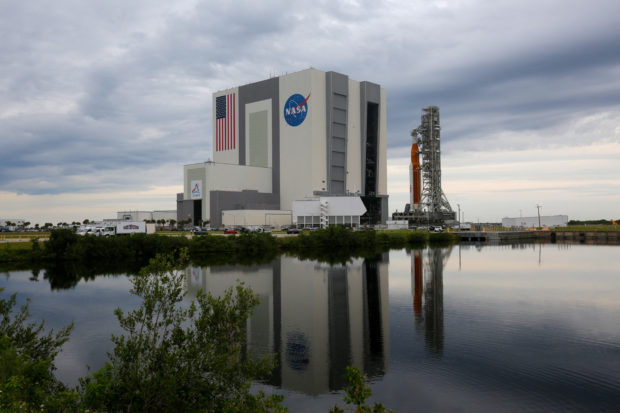
giant Artemis 1 moon rocket is rolled back to the Vehicle Assembly Building off its lauchpad, after postponing the much-anticipated mission a third time due to the arrival of Hurricane Ian and other technical problems, in Cape Canaveral, Florida, U.S. September 27, 2022. REUTERS FILE PHOTO
Nasa has targeted Nov. 14 for a third attempt to launch its big, next-generation rocketship, the U.S. space agency said on Wednesday, after weeks of technical setbacks and foul weather delayed the uncrewed inaugural Artemis mission to the moon.
Plans call for rolling the 32-story-tall Space Launch System (SLS) rocket and its Orion capsule back out to Launch Pad 39B at Nasa’s Kennedy Space Center in Cape Canaveral, Florida, as early as Friday, Nov. 4 to renew final flight preparations.
Safety regulations and deteriorating weather conditions spawned by Hurricane Ian had forced the space agency to return the towering rocketship to its hangar last month following two aborted launch attempts, on Aug. 29 and Sept. 3.
Standard maintenance still to be done at the pad includes repairing minor damage to insulation materials, and recharging or replacing batteries on the rocket, and on its satellite payloads and flight-termination system, Nasa said in a statement announcing the new launch date.
Nasa officials have previously said that a hydrogen fuel leak that forced them to scrub the last countdown three hours before liftoff has since been resolved.
The newly targeted 69-minute launch window for the Artemis I mission on Nov. 14 opens at 12:07 a.m. EST (0407 GMT), with backup launch opportunities of two hours each set for Nov. 16 and Nov. 19, Nasa said.
The latest string of difficulties in recent months come at the tail end of a rocket development program more than a decade in the making, with years of delays and billions of dollars in cost overruns under Nasa’s SLS and Orion contracts with Boeing Co and Lockheed Martin Corp, respectively.
Apart from its technical challenges, Artemis I signals a major turning point for Nasa’s post-Apollo human spaceflight program, after decades focusing on low-orbit missions with space shuttles and the International Space Station.
Artemis I, aimed at launching the Orion capsule on an uncrewed test flight to the moon and back, would mark the debut voyage of both the SLS rocket and Orion a half century after the final lunar mission of Apollo, forerunner of the Artemis program.
Named for the goddess who was Apollo’s twin sister in ancient Greek mythology, Artemis seeks to return astronauts to the moon’s surface as early as 2025, though many experts believe that time frame will likely slip.
Nasa ultimately plans to establish a long-term lunar base of operations as a stepping stone to even more ambitious human voyages to Mars.
RELATED STORIES
To the Moon and beyond: Nasa’s Artemis program
Nasa unsure next Moon rocket launch possible this month